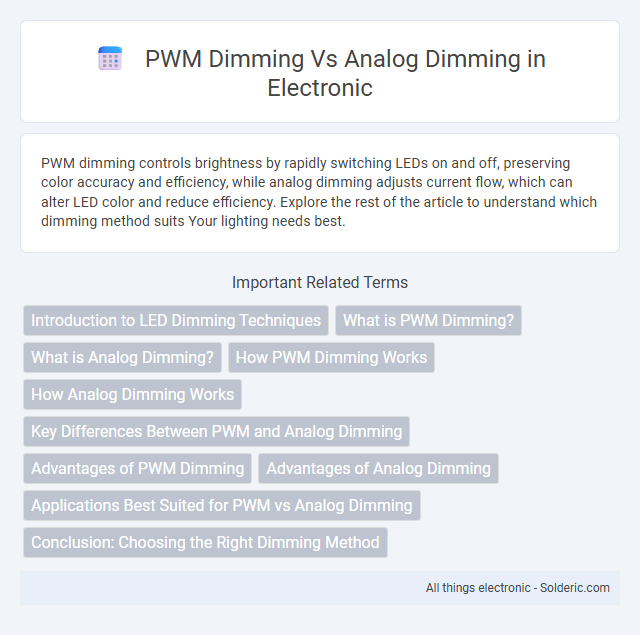PWM dimming controls brightness by rapidly switching LEDs on and off, preserving color accuracy and efficiency, while analog dimming adjusts current flow, which can alter LED color and reduce efficiency. Explore the rest of the article to understand which dimming method suits Your lighting needs best.
Comparison Table
| Feature | PWM Dimming | Analog Dimming |
|---|---|---|
| Definition | Uses pulse width modulation to control LED brightness by switching on/off rapidly. | Adjusts LED brightness by varying the current continuously. |
| Brightness Control | Precise and stable brightness levels. | Brightness depends on current level; less precise. |
| Color Accuracy | Maintains consistent color output. | Color shifts possible due to current variation. |
| Power Efficiency | High efficiency; minimizes power loss. | Lower efficiency; increased heat dissipation. |
| EMI Emissions | Potential for electromagnetic interference due to switching. | Minimal EMI; smooth current flow. |
| Complexity | Requires PWM controller and switching circuitry. | Simple circuit; linear current control. |
| Recommended Applications | Displays, automotive lighting, and precise brightness control. | Simple lighting, low-cost applications, and dimmable LED bulbs. |
Introduction to LED Dimming Techniques
LED dimming techniques primarily include PWM (Pulse Width Modulation) dimming and analog dimming, both offering distinct advantages for controlling brightness levels efficiently. PWM dimming adjusts the duty cycle of a digital signal to regulate LED intensity without affecting color temperature, making it ideal for applications requiring precise and flicker-free control. Analog dimming changes the LED's drive current to vary brightness but may impact color accuracy and generate more heat, influencing your choice based on performance and longevity requirements.
What is PWM Dimming?
PWM dimming controls LED brightness by rapidly switching the light on and off at a high frequency, creating the perception of varying intensity without changing the LED's color temperature. This technique provides precise brightness control and improved energy efficiency, making it ideal for applications requiring consistent and flicker-free lighting, such as in displays and automotive lighting. Your choice of PWM dimming ensures stable LED performance and longer lifespan compared to analog dimming methods.
What is Analog Dimming?
Analog dimming controls LED brightness by adjusting the continuous current flowing through the LED, providing smooth and flicker-free light output. This method reduces power to the LED directly, allowing precise control over the light intensity but may cause color shifts at lower brightness levels. Your choice between analog and PWM dimming depends on the need for color accuracy and flicker sensitivity in your lighting application.
How PWM Dimming Works
PWM dimming works by rapidly switching the LED on and off at a high frequency, controlling brightness through the duty cycle rather than current magnitude. The duty cycle represents the percentage of time the LED is illuminated during each cycle, allowing precise brightness adjustment without color shift. This method ensures efficient power use and stable LED performance, making PWM dimming ideal for applications requiring accurate light control.
How Analog Dimming Works
Analog dimming works by adjusting the voltage supplied to an LED, thereby controlling the current flow and directly influencing the light intensity in a smooth and continuous manner. Unlike PWM dimming, which switches the LED on and off at high frequencies, analog dimming maintains a steady light output without flicker, making it ideal for applications requiring consistent brightness levels. Your choice between analog and PWM dimming depends on factors like energy efficiency, color stability, and the specific lighting environment.
Key Differences Between PWM and Analog Dimming
PWM dimming adjusts brightness by rapidly switching the LED on and off at a high frequency, maintaining color consistency and efficiency, while analog dimming reduces brightness by lowering the voltage supplied, which can cause color shifts and heat buildup. PWM offers precise control and minimal power loss, making it ideal for applications requiring stable color performance. Your choice between PWM and analog dimming depends on the need for color accuracy, efficiency, and dimming smoothness in the lighting system.
Advantages of PWM Dimming
PWM dimming offers precise brightness control by rapidly switching the LED on and off at high frequencies, preventing color shifts and maintaining consistent light quality. It provides higher energy efficiency and reduces heat generation compared to analog dimming, which lowers power to the LED and can cause thermal instability. PWM also enables smoother dimming transitions without flicker, enhancing user experience in LED lighting applications.
Advantages of Analog Dimming
Analog dimming provides smoother and flicker-free control of LED brightness, enhancing visual comfort in various lighting applications. It enables precise current regulation, improving energy efficiency and extending the lifespan of LED components. Unlike PWM dimming, analog dimming minimizes electromagnetic interference, making it ideal for sensitive electronic environments.
Applications Best Suited for PWM vs Analog Dimming
PWM dimming excels in applications requiring precise and flicker-free light control, such as LED displays, automotive lighting, and medical devices, where maintaining color consistency and brightness accuracy is critical. Analog dimming suits environments with simple lighting needs like residential and commercial indoor lighting, where smooth dimming transitions and cost-effectiveness are prioritized. High-frequency switching in PWM supports high-efficiency and longevity of LEDs, while analog dimming provides straightforward implementation with minimal electromagnetic interference.
Conclusion: Choosing the Right Dimming Method
PWM dimming offers precise brightness control with minimal color shift and higher energy efficiency, making it ideal for LED applications requiring dynamic lighting adjustments. Analog dimming can introduce color distortions and reduced efficiency but provides simpler implementation for constant, lower-power settings. Selecting the appropriate dimming method depends on application-specific needs such as color fidelity, energy savings, and control complexity.
PWM dimming vs Analog dimming Infographic

 solderic.com
solderic.com